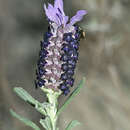en
names in breadcrumbs


Lavandula stoechas, the Spanish lavender or topped lavender (U.S.) or French lavender (U.K.),[1] is a species of flowering plant in the family Lamiaceae, occurring natively in several Mediterranean countries, including France, Spain, Portugal, Italy, Turkey and Greece.[2]
It is an evergreen shrub that usually grows to between 30 and 100 cm tall and occasionally up to 2 m (6.5 ft) tall in the subspecies L. stoechas subsp. luisieri. Its leaves are 1–4 cm long, greyish and tomentose. The inflorescence is crowned by a mass of purple elongated ovoid bracts about 5 cm long. Lower flowers form a tight rectangle in cross-section. The upper of the five teeth has a wrong-heart-shaped appendage. The crown is blackish-violet, up to 8 mm long and indistinct two-lipped.
The flowers, which appear in late spring and early summer, are pink to purple, produced on spikes 2 cm long at the top of slender, leafless stems 10–30 cm (4–12 in) long; each flower is subtended by a bract 4–8 mm long. At the top of the spike are a number of much larger, sterile bracts (no flowers between them), 10–50 mm long and bright lavender purple (rarely white). It blooms in spring and early summer, from the month of March in its native habitat, depending on the climate in which it grows.[3]
The Latin specific epithet stoechas comes from the Greek stoichas meaning “in rows”. It is also the Greek name for this species.[4]
The recognised subspecies are:
This species is more tender than common lavender (Lavandula angustifolia), being less frost-resistant, but harsher and more resinous in its oils. Like other lavenders, it is associated with hot, dry, sunny conditions in alkaline soils. However, it tolerates a range of situations, though it may be short-lived. Hardy down to −10 °C (14 °F)[1] (USDA zones 8–10).
The following cultivars have won the Royal Horticultural Society's Award of Garden Merit:-[6]
The flowers are used in aromatherapy to prepare infusions and essential oils that contain ketones (d-camphor and d-fenchone) and alcohols (borneol and terpineol).[10]
Since its introduction into Australia, it has become an invasive species, widely distributed within the continent. It has been declared a noxious weed in Victoria since 1920. It also is regarded as a weed in parts of Spain.[11]
Lavandula stoechas, the Spanish lavender or topped lavender (U.S.) or French lavender (U.K.), is a species of flowering plant in the family Lamiaceae, occurring natively in several Mediterranean countries, including France, Spain, Portugal, Italy, Turkey and Greece.